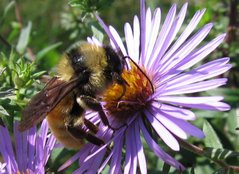
I spent the day at Presquile Provincial Park, near Brighton, Ontario. I crashed this funeral service for what appears to be a Common Loon. I'm not trying to be deliberately morbid. I actually have a scientific purpose for the pictures that follow, bare with me, and parents, please supervise your children. This will get messy.



You can see by the feet and the bill that this is probably a Common Loon. What I want you to take a close look at is the little black dot at the bottom left of his belly. You see a line and just to the right of it is the little dot.

Here we have the remains of what appears to be a Long-tailed Duck. This would have been a new species for me but my son insists I can't count a dead bird. If any professional birders out there would like to contradict him please email me. But back to my point, please note the tiny bug on the centre front of the bird. CSI types, get to work!

Next dead bird, all on the same beach, all within a few hundred yards of each other. Note the speck on the centre of this bird. OK, here it is in a clear macro shot.
 What is this beetle and why is it sitting on all these dead birds? I know that beetles are voracious eaters of small living things, but does this beetle specialize in the dead? Is it some kind of carion beetle. Calling all entomologists!
What is this beetle and why is it sitting on all these dead birds? I know that beetles are voracious eaters of small living things, but does this beetle specialize in the dead? Is it some kind of carion beetle. Calling all entomologists!

9 comments:
Really you can make up whatever rules for counting birds you want, if it is for your own list. (Just be consistent.)
But officially dead birds are not counted. For example, the ABA Listing Rules state that "The bird must have been alive, wild, and unrestrained when encountered." The NJ Audubon Society's rules for the World Series of Birding (pdf) make the same point.
Of course, both of those are setting standards for competitive listers. If you want to use different ones, that is up to you, and long as you adhere to the standard ones if submitting lists to birding clubs, etc.
By the way, I love the photographs here. The last beetle shot was interesting.
Thanks for this disappointing info. He stays off the list, only the official rules for me. This is a serious site and we won't mess with the rules.
Another ABA rule that I find confining at times is that the bird must be native or at least naturalized. The joy you might feel at spotting an unexpected peacock in the middle of the forest (which I've done) is tempered considerably by the fact that the sighting won't officially count until you see one in India or Asia.
I guess that rules out sightings at the zoo as well. I think with regard to the peacock though I would engage in civil disobedience and add it to the list.
I only count non native birds if they have an established feral populataion. I don't therefore, count any bird that is an escapee, or enclosed in a zoo, or someones pet.
But no one answered your beetle question! I don't bird watch but I'd like to learn how. I love birds. I want to know about that beetle! I had no idea. I think I'm glad I've never seen one of THOSE before!
Nannothemis over at Urban Dragon Hunters has suggested that this beetle is a Spotted Cucumber Beetle http://bugguide.net/node/view/29805
The information that I read didn't indicate that they ate anything other than plants and that has kind of thrown me off. I'll see if I get other confirmations or suggestions.
It looks like my spotted cucumber beetle: http://snailstales.blogspot.com/2005/09/backyard-bugs-i-spotted-cucumber.html
It is absolutely a spotted cucumber beetle and I am not sure why it is on those dead birds, or on the beach for that matter. It is definitely not a carrion feeder.
Post a Comment